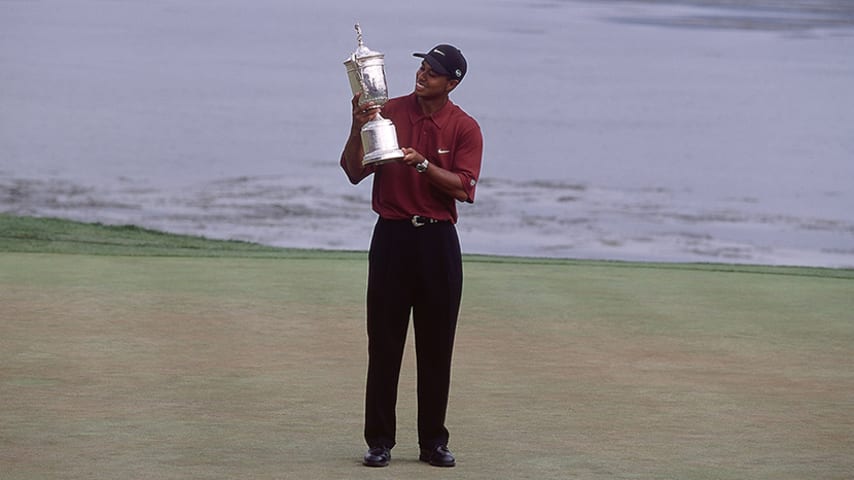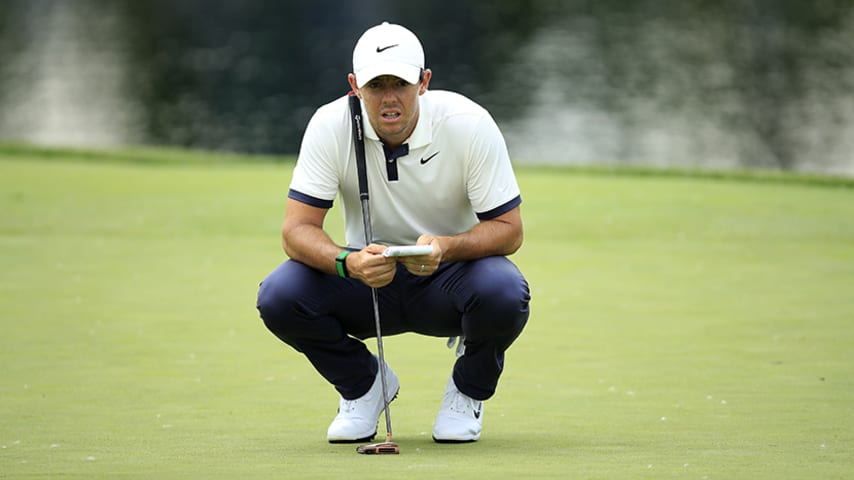The Jedi mind tricks of Tiger’s 2000 U.S. Open win
6 Min Read

18 Jun 2000: Tiger Woods of the USA poses with the winning trophy after winning the 100th US Open held at the Pebble Beach Golf Links, in Pebble Beach, California. \ Mandatory Credit: David Cannon /Allsport
Tiger Woods’ record 15-shot win at Pebble Beach was fueled by his mystical putting
Written by Cameron Morfit
Tiger Woods’ record 15-shot win at Pebble Beach was fueled by his mystical putting
There were lots of amazing things about Tiger Woods’ 15-shot victory at the 2000 U.S. Open at Pebble Beach, starting with the fact that no player has won by 15 or more shots on the PGA TOUR since 1948. Johnny Miller and Tom Watson were among those calling it the best golf ever played; others have argued it ranks among the most dominant sports performances ever, if not the most dominant. Woods beat the field average by a career-best 29 strokes for the week.
But it was his putting, in particular, that still confounds those who were there.
“He had some Jedi powers; he could pretty much will the ball in the hole,” says Jesper Parnevik, who played the first two rounds that week with Woods and Jim Furyk. “And sometimes I could swear he did because I would think the ball was going to miss or already had missed, and it would go in sideways. That’s some strong-ass, Obi-Wan Kenobi/Jedi stuff going on.
“It was almost as if he was making the putts with his mind instead of his putter.”
Woods, then just 24, was at the height of his powers. He’d won 11 of his previous 20 starts on TOUR and would win not only this major but the next three (the so-called Tiger Slam). Still, there was nothing quite like what he did at Pebble, especially on the fickle greens. His putting that week has taken on an almost mythical quality as he returns to the fabled seaside course in search of his 82nd TOUR win, which would tie Sam Snead’s record, and 16th major title.
It started with his marathon session on the practice green at Pebble on Wednesday night – he, ahem, didn’t like the way the ball was rolling into the hole – and paid immediate dividends.
Woods one-putted 12 times in his opening-round 65 (24 putts total) and would one-putt 20 of the first 38 greens despite surfaces that John Huston called the bumpiest he’d ever seen. Fans on site and at home watched in awe. And as with Brooks Koepka at last month’s PGA Championship at Bethpage Black, playing partners shook their heads in a combination of wonder and despair.
Parnevik admits he was so overmatched, it became a running joke, he and Woods laughing as the lesser player scuffled his way around the course. The Swede already had won twice that year but was in considerable pain and about to go in for much-needed hip labrum surgery that would keep him out of action until the TOUR Championship.
“I was pretty much crippled and couldn’t get onto my left side,” he says. “I hit it knee-high every shot. It was probably the best golf ever (by Woods), and I couldn’t make contact, so it was kind of funny trying to compete with this guy.” (Parnevik shot 73-80 and missed the cut.)
Still, while the five-time TOUR winner Parnevik was a lost cause, he and his then-caddie, Lance Ten Broeck, marveled at what they were seeing from Woods.
“First of all, we were impressed with how he played, but what was really impressive was the complete certainty with which he holed out from everywhere,” says Parnevik, 54, who now plays on PGA TOUR Champions and won the 2016 Insperity Invitational. “You could tell he had zero doubts in his mannerisms, that he was going to make everything.”
After taking just 24 putts in the first round, Woods, in the fog-delayed second (69, 29 putts), made a 30-footer for birdie in the semi-darkness at the 12th hole just before officials halted play Friday night. He never had a three-putt.
Jedi powers? Perhaps.
The tournament predated ShotLink, so ball-position data is not available, but it has been reported that Woods didn’t miss a putt from inside 8 feet. Furyk said he made 8-footers like they were 2-footers. And while seaside poa annua greens are famously quirky, and more accurately a mix of different grasses (poa, bent, fescue) plus flecks of sand, Woods seemed to intuit every bump and wobble.
The 2000 U.S. Open also predated the Strokes Gained: Putting stat, but you can guess who would have led it. Woods was sixth in the field with 110 total putts, but first in Greens in Regulation (51/72) by a mile. In other words, the five players with fewer putts – Nick Faldo, Lee Porter, Loren Roberts, Padraig Harrington and Lee Westwood – were more often chipping up close for one-putt par saves, the kind of thing that the SG: Putting metric exposes as smoke and mirrors.
Woods, meanwhile, was putting for birdie 71 percent of the time. Next best that week: Fred Couples and David Toms at 61 percent. “The guy drives the ball better than anyone I’ve seen,” Faldo said back then. (Woods easily led the field in Driving Distance, averaging 299.3 yards.) “And he putts better than [Ben] Crenshaw. When you put that together, he’s hard to beat.”
Runner-up Ernie Els was 10 behind as he and Woods teed off in the final round, and later acknowledged he knew he had no chance. He said Woods and the rest of the field were not even in the same ballpark. “If I played out of my mind,” Els said that Sunday afternoon at the media center, “I probably still would have lost by 5, 6, 7.”
Someone then referenced the 1862 Open Championship when Old Tom Morris won by 13 strokes. That had been the previous biggest winning margin in major championship golf.
“If you put Old Tom Morris with Tiger Woods, he'd probably beat him by 80 shots right now,” Els replied. “Hey, the guy is unbelievable, man. I guess he's the first guy to ever go into double figures in a U.S. Open. As you say, to win by 15 strokes, biggest margin in a major. I'm running out of words. Give me a break.”
Nineteen years later, the dominance that Tiger displayed that week still remains vivid in Parnevik’s mind.
“Not only did he have all the shots but he hit all the shots,” Parnevik says. “He hit it high, low, right, left – every shot he hit was pretty much different from the shot before.
“He was playing with full certainty about not only where his ball was going to go, but that he was going to win every week. That’s what so great about the younger guys and the new crowd getting a glimpse of it today. It’s not what it was, but they’re at least getting a tiny understanding of it, how he’s been able to come back.”






